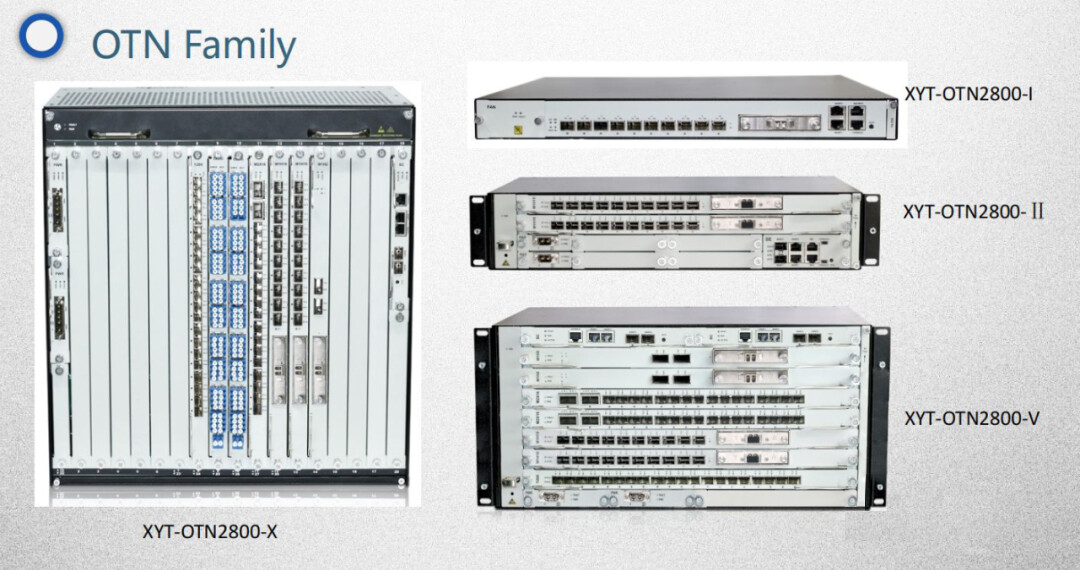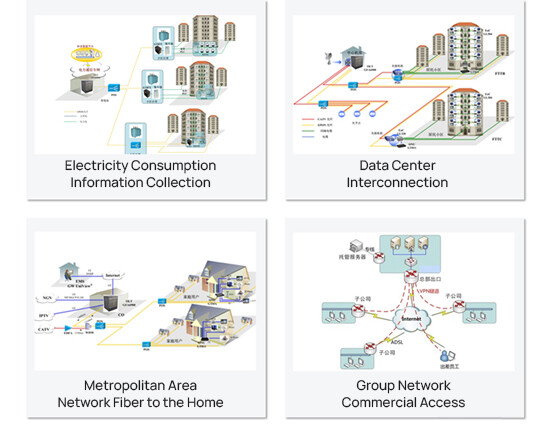OTN (Optical Transport Network) is a next generation backbone transport network based on WDM technology and organised on the optical layer. In short, it is a next generation transport network based on wavelength division.

Introduction
OTN is a new generation of "digital transport system" and "optical transport system" based on WDM technology and organised at the optical layer, which is the next generation of backbone transport network. OTN is a new generation of "digital transport system" and "optical transport system" standardized by a series of ITU-T recommendations such as G.872, G.709 and G.798, which will solve the problems of traditional WDM networks with no wavelength/sub-wavelength service scheduling capability, weak networking capability and weak protection capability, etc. OTN solves a series of problems of traditional systems through a series of protocols, spanning the traditional electric domain (digital transport) and optical domain (analog transport), and is a unified standard for managing the electric and optical domains.
OTN deals fundamentally with wavelength-level services and it advances the transport network to a true multi-wavelength optical network stage. Thanks to the combination of optical and electrical domain processing, OTN offers huge transmission capacity, fully transparent end-to-end wavelength/sub-wavelength connectivity and carrier-grade protection, making it the optimal technology for delivering broadband, large granular services.
Key benefits
The main advantage of OTN is that it is fully backward compatible, it can build on existing SONET/SDH management functions, it not only provides full transparency of the communication protocols that exist, but also provides end-to-end connectivity and networking capabilities for WDM, it provides specifications for optical layer interconnections for ROADM and complements sub-wavelength aggregation and sparing capabilities. The end-to-end linking and networking capability is built primarily on SDH and provides a paradigm for the optical layer.
The OTN concept covers both optical and electrical layer networks, and its technology inherits the dual advantages of SDH and WDM, with key technical features embodied in:
1. Multiple customer signal encapsulation and transparent transmission
The OTN frame structure based on ITU-TG.709 can support the mapping and transparent transmission of various customer signals, such as SDH, ATM, Ethernet, etc. ITU-TG.sup43 provides additional recommendations for different levels of transparent transmission for 10GE services, while for GE, 40GE, 100GE Ethernet, private network services Fibre Channel (FC) and access network services Gigabit Passive Optical Network (GPON) The standardised mapping of these to OTN frames is currently under discussion.
2. Bandwidth multiplexing, crossover and configuration at large granularity
OTN defines the bandwidth granularity of the electrical layer as optical path data units (O-DUK, k=0,1,2,3), i.e. ODUO (GE, 1000M/S) ODU1 (2.5Gb/s), ODU2 (10Gb/s) and ODU3 (40Gb/s), and the bandwidth granularity of the optical layer as wavelengths, as opposed to the scheduling granularity of VC-12/VC-4 for SDH The OTN multiplexing, crossover and configuration granularity is significantly larger, which can significantly improve the adaptation capability and transmission efficiency of high bandwidth data customer services.
3. Powerful overhead and maintenance management capabilities
OTN provides similar overhead management capabilities to SDH, and the OTN frame structure at the OTN optical path (OCh) layer greatly enhances the digital monitoring capabilities of this layer. In addition OTN offers 6 layers of nested Tandem Connection Monitoring (TCM), which makes it possible to take an end-to-end and multi-segment simultaneous performance monitoring approach to OTN networking. Suitable management tools are provided for cross-operator transmission.
4. Enhanced networking and protection capabilities
The introduction of OTN frame structures, ODUk crossovers and multi-dimensional reconfigurable optical division and multiplexers (ROADM) has greatly enhanced the networking capabilities of optical transport networks, changing the status quo based on SDH VC- 12/VC-4 scheduling bandwidth and WDM point-to-point provision of high-capacity transport bandwidth. The adoption of Forward Error Correction (FEC) technology has significantly increased the distance of optical layer transmission. In addition, OTN will provide more flexible service protection functions based on the electrical and optical layers, such as optical subnetwork connection protection (SNCP) and shared ring protection based on the ODUk layer and optical channel or multiplexed segment protection based on the optical layer, but the shared ring technology has not yet been standardised.
Application scenarios
OTN-based intelligent optical networks would provide a highly desirable solution for the transmission of large granular broadband services. The transmission network is mainly composed of inter-provincial trunk transmission network, intra-provincial trunk transmission network and metropolitan (local) transmission network, which can be further divided into core layer, convergence layer and access layer. The biggest advantage of OTN technology over SDH is that it provides large granular bandwidth scheduling and transmission. Therefore, whether OTN technology is used at different network levels depends on the size of the bandwidth granularity of the main scheduling services. According to the current status of the network, the main granularity of scheduling at the core layer of inter-provincial trunk transmission networks, intra-provincial trunk transmission networks and metro (local) transmission networks is generally Gb/s and above, so OTN technology with better advantages and scalability can be used to build these layers in preference. For the convergence and access levels of metropolitan (local) transport networks, OTN technology is also preferred when the main scheduling particles reach the Gb/s level.

1. National backbone optical transport network
With the IP-based network and services, the development of new services and the rapid increase in broadband users, IP traffic on national trunk lines has increased dramatically and bandwidth demand has grown exponentially year on year. WDM national trunk lines carry PSTN/2G long-distance services, NGN/3G long-distance services, Internet national trunk line services and so on. Due to the huge amount of bearing services, the WDM national trunk line has a very urgent need for protection of bearing services.
After adopting OTN technology, the bearing mode of national trunk IP over OTN can realize SNCP protection, ring network protection similar to SDH, MESH network protection and other network protection methods, and its protection capacity is comparable with SDH, moreover, the equipment complexity and cost are also greatly reduced.
2. Intra-provincial/regional backbone optical transmission network
Intra-provincial/regional backbone routers carry services between long-distance bureaus (NGN/3G/IPTV/Large Customer Line, etc.). Through the construction of provincial/regional backbone OTN optical transmission network, safe and reliable transmission of GE/10GE, 2.5G/10GPOS large grain services can be realized; ring network, complex ring network and MESH network can be formed; network can be expanded on demand; wavelength/sub-wavelength service cross scheduling and sparing can be realized, and wavelength/sub-wavelength large customer private line services can be provided; other services such as STM-1/ 4/16/64SDH, MESH network, etc. can also be realized. 4/16/64SDH, ATM, FE, DVB, HDTV, ANY, etc.
3. Metro/Local Optical Transport Network
In the core layer of the metro network, OTN optical transport network can realize the transmission of large grain broadband services between the metro convergence router, local network C4 (district/county centre) convergence router and the metro core router. For Ethernet services, Layer 2 convergence can be realized to improve the bandwidth utilization of the Ethernet channel; wavelength/sub-wavelength service can be channelized to realize wavelength/sub-wavelength private line service access; bandwidth operation can be realized by realizing bandwidth-on-demand and optical virtual private network, etc. From the group network, the network structure of the complex metropolitan transmission network can also be reorganized, making the hierarchy of the transmission network more clear.
4、Construction of proprietary networks
With the increase in demand for enterprise network applications, large enterprises, government departments, etc., also have the demand for large-grain circuit scheduling, while the private network is very poor in fiber resources compared to the carrier network, the introduction of OTN not only increases the scheduling flexibility of large-grain circuits, but also saves a large amount of fiber resources.
In the access layer of the MAN, with the downward shift of broadband access equipment, DSLAM access equipment such as ADSL2+/VDSL2 will be widely used, and GE uplink will be adopted; with the increasing number of GE dedicated line users in the group, the number of GE interfaces will also be increased in large numbers. is appropriate. A large number of GE services need to be transmitted to the BAS and SR of the end office. The combination of OTN or OTN + OCDMA-PON is a better choice, which will greatly save the rapid consumption of fiber resources caused by direct fiber connection, and at the same time, OTN can be used to achieve service protection and enhance the manageability and operability of the bandwidth resources of the access layer of the MAN.
Development trends
OTN is a new technology to the application, but its own development has been mature for many years, and the ITU-T has started the development of OTN standards since 1998, and by 2003 the main standards have been basically completed, such as OTN logical interface G.709, OTN physical interface G.959.1, equipment standard G.798, jitter standard G.8251, protection G.873.1, etc. In addition, the ITU-T has also completed the development of the main specifications for the OTN-based control and management planes.
In addition to the increasing development of standards, OTN technology has also progressed rapidly in recent years in terms of equipment and test instrumentation. Mainstream transport equipment vendors generally support one or more types of OTN equipment. In addition, mainstream transport instrumentation vendors generally offer OTN-enabled instrumentation.
With the strong drive for rapid service development and the increasing maturity of OTN technology and implementation, OTN technology has been partially applied in trial or commercial networks. In the US and Europe, the larger network operators such as Verizon and Deutsche Telekom have established G.709 OTN networks as a new generation of transmission platforms. OTN is expected to see massive growth in the coming years.
Foreign operators have generally made significant demands on the ability to support OTN interfaces in their transport networks, while the actual network applications are dominated by ROADM equipment, which is mainly related to factors such as network management and maintenance costs and network scale. Since 2007, China Telecom, the former China Netcom and China Mobile Group have carried out research and testing on the application of OTN technology, and some provincial networks have also partially deployed trial networks based on OTN technology, with OTN equipment based on electrical layer crossover and ROADM-based OTN equipment. OTN equipment. Due to the high maintenance cost of ROADM compared to the current maintenance system, ROADM has only been used in small-scale experiments by some operators, while OTN equipment based on electrical layer crossover has been used on a large scale by major operators such as China Mobile, Telecom, Unicom and Broadcast, as well as large private networks such as Southern Power and Sinopec.
As the best choice for the development of transport network technology, it can be expected that OTN technology will be more widely used in the near future, becoming the technology of choice for operators to create an excellent network platform and expand their business market.